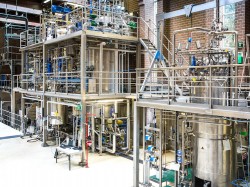Upscaling of tannin hot water extraction
Recent studies within Rehap have revealed that Europe has significant amounts of straw available from agricultural waste, and bark from forestry waste. This biomass contains natural building blocks such as tannin, lignin, cellulose and hemicellulose, which can be turned into substitutes for petrochemicals in the green building sector. Having now found where these underutilised residues are, Rehap is in the process of developing an optimised extraction, fractionation and purification protocol for the recovery of tannins from softwood barks. It is also testing the scale-up potential of this process to produce adequate amounts for further project testing. To do this, Rehap is working closely with the team at Bio Base Europe Pilot Plant (BBEPP) in Ghent, Belgium. BBEPP is a flexible and diverse pilot plant for the development and scale-up of new or existing bio-based and sustainable processes to an industrial level. It performs the entire process from the green resources to the final product. Extracting tannins from bark In the latest lab-scale trials, Rehap looked at upscaling the hot-water extraction of tannins. Initially, the extraction of tannins from bark was developed by partners VTT, the Technical Research Centre of Finland, and was successfully transferred to the lab at BBEPP, where it has been scaled-up to pilot scale. In order to ensure that the upscaling process is smooth, the different unit operations (mixing bark with water; heating mixture; cooling mixture; separating bark residue; concentrating tannin liquid) were first scaled to kilograms, before being fine-tuned to see how they performed in order to identify the most suitable options for each unit operation. The first step involved mixing the bark with water to extract the tannins at 90 °C, also called hot water extraction. After this, different techniques such as filtration, centrifugation (separating the mixture through spinning), decantation (separating mixtures by removing a liquid layer free from precipitate) and sedimentation were each performed and evaluated in order to see how the tannin solution separated from the bark residue after hot water extraction. Decantation combined with centrifugation performed the best and was found to be the most suitable technique. Finally, the clarified tannin solution was evaporated on a falling film evaporator, an industrial device used to concentrate solutions. This resulted in approximately 150 kg of tannin extract from 4 m³ of bark, giving a similar output to the process originally developed by VTT. This amount of tannin solution is excellent and should be sufficient for Rehap partners Foresa and Rampf for further modification.
Countries
Belgium, Germany, Spain, Finland, France, Italy, United Kingdom



